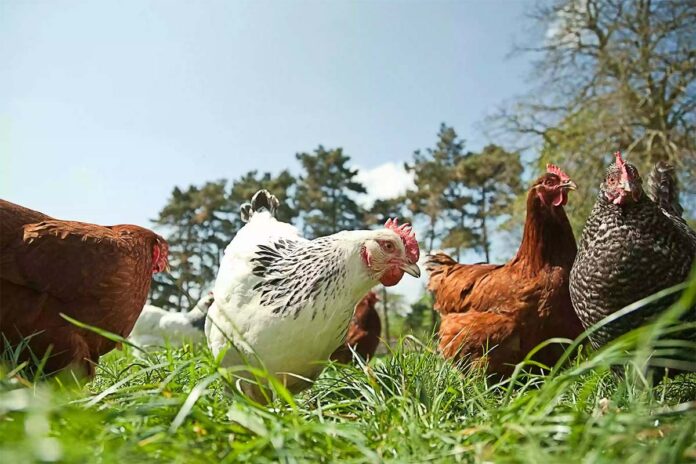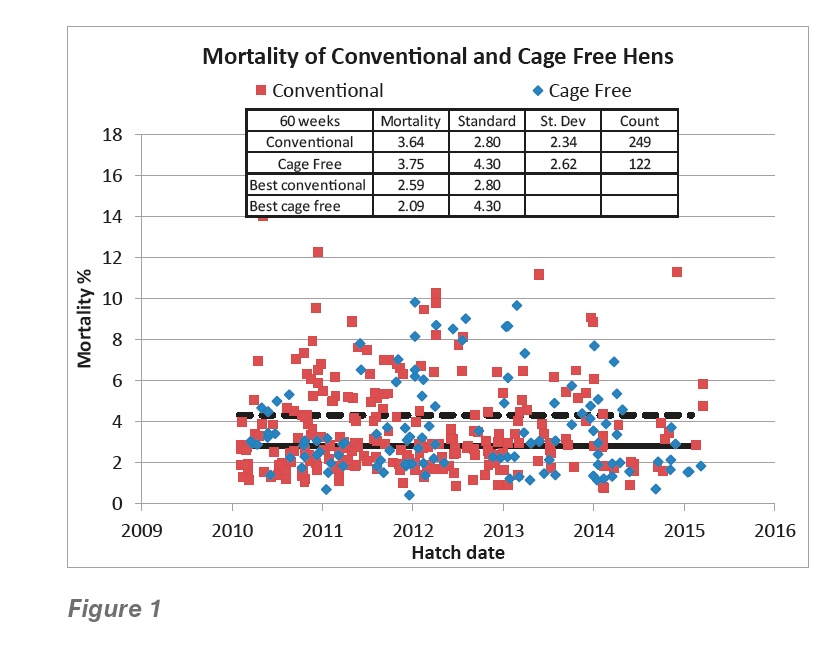
In USA and Europe there has been a growth in cage-free, free range, and organic production over the last 10 years.
The percentage of all cage-free production has been growing steadily. In the USA as of October 2017, there was 84.2% conventional, enrichable, and enriched, 11.1% cage-free (barn) and 4.7% organic out of approximately 7 million laying hens. Additionally, cage-free pledges by multinational corporations has the potential to spread this style of production to countries where there may be little to no local demand outside of the brands offering this product.
The cost of cage-free production can be up to 30 – 40% higher than conventional cage systems. While this economic impact can change the demand for eggs on the free market, a potential bigger disrupter is the variability of production inherent in cage-free systems.
Health issues in cage-free flocks
Cage-free hens are subject to the same diseases as any other chicken. A well-managed cage-free flock can have the same or better mortality than a conventional style flock; however, any hens that have access to litter or pasture have a greater chance of coming in contact with a number of diseases and management challenges that are either unique or accentuated by the cage-free environment.

Bacterial
Avian Intestinal Spirochetosis
Brachyspira are gram-negative bacteria that affect the intestines of chickens. There are three main pathogenic species B. intermedia, B. pilosicoli, B. alvinipulli. Clinical signs include foul-smelling, caramel- colored, foamy droppings and dark brown sticky residue on eggs that is very difficult clean. Brachyspira can cause drops in production or difficulty in persistency. Brachyspira are found in all production systems but can be worse in cage-free flocks, especially flocks that have access to outdoor areas that are difficult to clean and disinfect. There are no vaccines for Brachyspira so treatment with antibiotics is the only option for non-organic flocks.
Colibacillosis
Avian pathogenic Escherichia coli (APEC) are gram-negative bacteria that can affect almost all systems of the chicken. E. coli can be both a primary and secondary pathogen. Due to the prevalence in the environment is often the cause of mortality for birds that are immunosuppressed from another disease including infectious bronchitis, Mycoplasma, and others. Common presentations of E. coli infection in chickens include colisepticemia, peritonitis, salpingitis, and air sacculitis. Cage free houses have been shown to have significantly higher levels of particulate matter and ammonia which can enhance conditions for colibacillosis. While not all peritonitis is caused by E. coli (Salmonella, Pasteurella, and Gallibacterium can also cause similar clinical signs), E. coli is often involved. Vaccination is an effective method to control colibacillosis using either an autogenous bacterin or live vaccine administered during rearing. Vaccination during an outbreak of E. coli has been demonstrated be occasionally effective in the absence of other options. Treatment for E. coli using antibiotics is an option for non-organic flocks although many of the available antibiotics with a zero-day egg withdrawal have limited efficacy.
Fowl Cholera
Pasteurella multocida is a gram-negative bacterium that can affect most types of birds and is typically a primary pathogen. While many animals could potentially be hosts for fowl cholera, this disease is often introduced to flocks as a result of biosecurity breakdowns and introduction from another flock of chickens. Clinical signs usually start in the respiratory tract for chickens, although with acute disease some birds may die without any sign of disease. For more chronic infections, the presentation of the disease can be similar to colibacillosis with wide spread septicemia and peritonitis. Swollen wattles are another common presentation of cholera. Fowl cholera vaccination is a good way to control the disease but is not used in all flocks on a routine basis. Flocks with a history of cholera or are in an endemic area should vaccinate. Both live and killed Pasteurella vaccines are available. Vaccination against Pasteurella must be done with a homologous serotype; the most common serotypes affecting chickens in the USA are A: 1, 3, and 4. For bacterins, commercial vaccines can be used or autogenous vaccines can be utilized and must be administered twice during the rearing period. There are two live attenuated strains given by wing web inoculation that can be used for lower challenge areas. Treatment for P. multocida works with sulfonamides, tetracyclines, and some other antibiotics; however mortality will often resume after the course of treatment ends.
Infectious Coryza
Avibacterium paragallinarum is a gram-negative bacterium with clinical signs characterized by facial swelling and a sticky nasal discharge. Infectious coryza is frequently a secondary pathogen for farms affected by other respiratory pathogens, but once in a flock can cause production drops of 10 – 40% and create biosecurity issues for other flocks on the same farm and the surrounding area. Similar to fowl cholera, coryza can be difficult to clean from a farm, especially a multiage farm where chickens are continuous reservoirs of disease even after treatment. Control of coryza using a bacterin vaccine is common for affected farms using a homologous vaccine for serotype A, B, or C. Treatment for coryza can be accomplished with sulfonamides, tetracyclines, and some other antibiotics; however mortality will often resume after the course of treatment ends.
Mycoplasmosis
Mycoplasma gallisepticum (Mg) and M. synoviae (Ms) are the common mycoplasmas that affect chickens. Mycoplasma species are small bacteria that lack a cell wall and do not survive well outside of the bird. Under normal conditions, Mycoplasma can survive for 2 – 3 days outside of the host bird and this is the basis for downtime for many farms. Breeding flocks around the world are kept free from Mycoplasma spp. because of vertical transmission to the chicks. The many flocks infected with Mycoplasma are infected from multi-age farms or surrounding birds. Clinical signs include drops in production, unthrifty birds, and respiratory signs. Co-infection with other pathogens such as infectious bronchitis and E. coli can make Mycoplasma infections much worse. Mg usually causes more production issues than Ms, but Ms can create a variety of issues including weak shells with some strains.
Vaccination is common in many parts of the world, especially on multi-age farms where the disease is endemic. There are 3 main strains of live Mg vaccine (TS11, 6/85, and F-strain) and one strain of Ms live vaccine (Ms-H). The vaccines are best administered by eye drop to ensure every bird gets a sufficient titer. An Mg bacterin is also available on the market but may have uneven efficacy. Treatment of Mycoplasma is effective with a variety of antibiotics, although re-treatment is common because the infection is sustained on the farm throughout the treatment period.
Ornithobacterium Rhinotracheale (ORT)
ORT is a gram-negative bacterial disease of chickens and turkeys that has started to affect more cage-free flocks in Europe. ORT typically causes respiratory signs and drops in production. There is no commercial vaccine although some farms with endemic issues use an autogenous vaccine. Treatment with antibiotics can be effective although a culture and sensitivity is essential as strains can vary widely. Disinfecting the waterlines and fogging the house with disinfectant in the face of infection can also help reduce the impact of disease.
Parasitic
Nematodes
Nematodes include many internal parasites of chickens, one of the most prevalent and damaging of which is roundworm or Ascaridia galli are a big challenge for cage-free production. A study in Europe found that the incidence of Ascaridia infections in cage-free hens was between 28 – 77% compared with less than 5% for caged hens. There is not a significant difference between infections in flocks with outdoor access and indoor only flocks once the worms have been brought onto the premise. Clinical signs include slow growth, anemia, and drops in production or changes in behavior for heavy infestations. Cleaning and disinfection between flocks is helpful although Ascaridia eggs are not affected by typical detergents and disinfectants. Treatment using fenbendazole may be necessary when parasite loads get too heavy.
Coccidiosis
Coccidia are protozoal parasites of the intestinal tract of chickens that are prevalent in most cage-free systems. There are seven main species of coccidia that effect chickens: Eimeria acervulina, Eimeria praecox, Eimeria maxima, Eimeria necatrix, Eimeria mitis, Eimeria brunetti, and Eimeria tenella. Each species of coccidia has a different affinity for portion of the intestinal tract and can cause differing levels of damage. Coccidia will cause mortality in young chicks and in pullets just moved into the layer house. Failure to thrive and gain weight is a common sign as well for young chicks leading to poor uniformity in flocks. There are three main approaches to controlling coccidia: cleaning, medicinal treatment, vaccination. Even though oocysts are resistant to most detergents and disinfectants, cleaning is essential to help reduce the load in the environment by removing as much organic material as possible. Medicinal treatment must be used on a rotation between products to help prevent buildup of resistance.
Vaccination is used on most cage-free flocks and can be very effective if the cycling of the vaccine over the first three of weeks on the farm is handled correctly.
Histomoniasis
Histomonas meleagridis (blackhead) is a protozoal disease of chickens that is linked to the cecal worm Heterakis gallinarum. Histomonas primarily causes lesions in the ceca and liver of chickens, including typical circular “target” lesions in the liver. The disease will cause a decrease in production and can result in high mortality. There are currently no drugs on the market that are effective against Histomonas so the only options are controlling the Heterakis worm burden by rotating pastures and cleaning barns well in between flocks.
Management of cage-free flocks
Diseases are not the only health issues facing cage-free birds. Cannibalism, feather pecking, and piling can all be significant contributors to flock mortality and may also be an indicator that an unnoticed disease has starting moving through the flock. With all cage-free birds, there is a smaller margin of error and a higher focus on management that is essential to have a successful flock. Training and acclimating birds to various environments and stimuli starting from day of age chicks is the best way help reduce management issues on the layer farm.
References are available on request
From the Proceedings of the Midwest Poultry Federation Convention

















